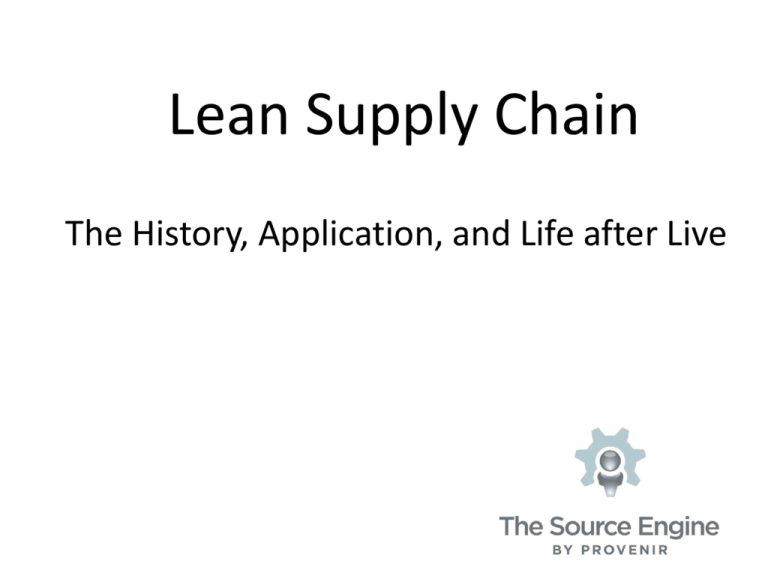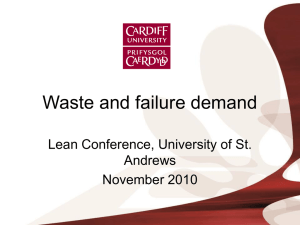Presentation - ISM San Antonio
advertisement

Lean Supply Chain The History, Application, and Life after Live Agenda –Introductions –Lean Definitions –History of Lean –Practical approach to Lean – Supply Chain deployment –Deployment discussion –Wrap up and questions Introductions • Why have a Chief Operating Officer of a Human Resource Consulting Company speak on Lean and Supply Chain? – Background – Principles created from desire to improve Manufacturing Operations – Finite ability to streamline operations • Systems • Measure results – Continuous Improvement initiatives – Examples Lean Definitions It is not Supply chain on a diet It is not a stand alone process Requires a cultural change within most organizations Lean Definitions Lean* Production practice that considers the expenditure of resources for any goal other than the creation of value for the end customer to be wasteful, and thus a target for elimination Value Any action or process that a customer would be willing to pay for Create “More Value with Less Work” *Wikipedia definition 5 Traditional vs. Lean Traditional Perspective •Some defects are acceptable •Errors will be caught by inspectors •Defects are fixed later •Higher quality = higher cost •Suppliers are adversaries •Quality results from inspection •Buy from lowest bidder •Low quality is caused by people •Quality is a function of the shop floor •Quality is the responsibility of QC •Management must discover problems •Statistics constitute a complex tool Lean Perspective •Defects are never acceptable •Employees catch mistakes •Defects are fixed now •Higher quality = higher profits/lower costs •Suppliers are trusted team members •Quality built into the product/process •Buy for quality/reliability •Low quality is caused by poor process management •Quality is a function of all functions •Quality is everyone's responsibility •Employees discover problems •Statistics can be used by anyone 6 Why deploy Lean? Inventory Turns On-time ship % Customer order ship time Sales Defects (PPM) Data entry (hrs/week) PO release Mat’l Mgt work week (hrs) Base year 15 97 8 Base$ 50 y Hours 60+ % improvement Base +5 50 333 99.99 3 4 50 Base X2$ 100 2 96 .25y 75 1 Min 99 40+ 33 Automotive manufacturing company results from a 5 year period By focusing on the Value Proposition your organization has to offer in the marketplace, the reward is virtually unlimited 7 History of Lean - Summary • Foundation built in United States in early 1900’s • After world war II concepts expanded in Japan – Toyota • Industrial Revolution in United States masked impending quality and cost Tsunami • 1980’s saw the rebirth of the United States quality programs • Late 1990’s early 2000’s began Holistic movement of quality to back office operations • Key concept: Lean is focused on getting the RIGHT things to the RIGHT place at the RIGHT time in the RIGHT quantity – while minimizing waste and implementing continuous improvement 15 Lean & Supply Chain Key Tenet • Key Tenet of Lean is Elimination of Waste • To eliminate – Must first understand • Shigeo Shingo noted • Only the last turn of the bolt tightens it – the rest is just movement • Toyota defined 3 types of waste – Muri – Mura – Muda 16 Types of Waste Defined • Muri • Unreasonable work management imposes on people and machines • Ask for higher performance than person or machine can achieve with out taking shortcuts • Usual cause of variations in product quality and output • Focuses on the preparation and planning of the process – what work can be avoided by design • Mura • Focus on implementation of work design • Elimination of fluctuations at scheduling or operations level – i.e. quality or volume • Muda • Results of the design and implementation of the process (Muri & Mura) • Managements role to investigate causes of variations caused by Muri and Mura • Feedback to the Muri 17 Typical Example • Quarter end – – “make the numbers” edict comes out – Demand is increased to make plan (Mura) – System is stressed causing extra capacity to be squeezed from the process • Standards relaxed • Short-cuts taken – Muri – Focus on shipping product at all cost - leading to downtime, mistakes, waiting, rework - Waste – Leads to Muda • • • • • • • Transportation (Moving products not required to perform the process) Inventory (not all WIP being processed) Motion (excess movement of people and materials) Waiting (Queue times extend) Overproduction ( build to stock) Over Processing ( equipment & process not geared for increased volume) Defects (Increase in rework and inspection) 18 Waste Elimination Three underlying Waste Elimination methods • Pull Scheduling Make what the customer is buying today • Takt time Change processes to run at rate which output is required • Flow Production Rearrange processes to eliminate batch processing Strive for most efficient way to process one (1) 19 Best In Class Misperception • Best in Class Companies* – 96% of orders delivered to customers complete and on time – 96% of orders received from suppliers complete and on time – Decreased by 3% total landed costs per unit in past year – Decreased by 3% supply chain execution cost relative to revenue *Aberdeen Group Focus shift Supply Chain Personnel Today Kaizen Acquisition Product Line Profitability Inventory Optimization Supplier Relationship Consulting Consulting Analysis Analysis Transactions Transactions Pricing Cost Elimination Multi-sourcing Funding Releasing purchase orders Expediting Quality tracking and reporting A true transformation of activities * Taken from Jean Cunningham's Real Numbers 21 Guiding Principles For Implementation Stepping back – Why are we interested in Lean Supply Chain? • In business to maximize profits by selling what the customer wants • Timely – Accurate - Meaningful – Actionable information • How do we do that? – 5 Principles 1. Value 2. Value Stream 3. Flow 4. Pull 5. Perfection 22 5 Guiding Principles 1. Value • Everything that a company does must add value • Every activity must be aligned or changed or eliminated • Set in marketplace – • Not cost plus markup to get selling price • i.e. Postal Service vs FedEx 5 Guiding Principles (Cont.) 2. Value Stream • • • • All items from raw materials to customer delivery Determined at Product/Service design Includes Invoicing – field service – etc…. When Lean is implemented – traditionally this is where folks begin 3. Flow • Products & Information should flow from inception to completion with no stops • Prime example of non continuous flow – leaf floating down a mountain stream • One Piece Flow • Control systems must be updated when moving from Job-shop (batch) to flow – i.e. no longer have materials sitting in queues – 24 no standard lot sizes – etc…. 5 Guiding Principles (Cont.) 4. Pull • Traditional ERP systems (Push) build to forecast (Inventory build) • Only build what Customers want – (small inventory) • Dynamic re-assignment of personnel to other tasks not related to building products • Will require change to performance benchmarks – Efficiency & Utilization become obsolete terms – One of the quickest ways to “Kill” a lean implementation • All downstream processes are driven by upstream demand 25 5 Guiding Principles (Cont.) 5. Perfection • Perfect quality – No inventory buffers– can’t afford defects – Quality programs and Lean Programs go hand-in-hand – Not just physical product quality – but right product at right place at right time (subassemblies) – Toyota Tundra plant – door glass example • Continuous improvement – Goes beyond the shop floor – Focus on driving waste out of the “system” 26 How do we do it? • Starts with the product and/or service being offered • People are the foundation – Empowered employee program must be underway • 5s methodology in-place • • • • • • • • • • • Sort Set in Order Shine Standardize Sustain Just in Time manufacturing based only on customer demand Quality designed into product and processes – not inspected in Suppliers included in design process Visual performance tracking Continuous improvement Cells vs traditional work centers 34 Some Common Misconceptions Regarding Lean • It is a management program to lay off workers • It is a management ploy to bust the union • It is a management ploy to make workers work harder for same pay • Management will lose control of the operation • It is to difficult to put in 35 Analyze the work flow 2nd Floor 1st Floor 8th Floor 37 Redesign the workplace/process 3rdFloor 3rdFloor 3rdFloor Measure & Refine Metrics 40 Deploying Lean • I’ve captured the low hanging fruit – now what? • The vision is to drive down transaction processing costs, while driving the work towards more value added analysis • Reduce overproduction with end goal to eliminate it • • • • • • • • • • • • High setup costs Making the numbers Poor quality – high scrap rates “Clean the plate” mentality Everything is running well – hate to stop Work to drive production cycle times to match customer consumption Make versus Buy analysis on every component Attempt to Continuous flow everything Be selective in areas where inventory buffers are created Tie customer trigger to pacing manufacturing item Educate the customers on your activities to help normalize demands Educate your suppliers to reduce variations and minimize outages 42 Post Deployment Discussion • Continuous process – does not end Act Plan Check Do • Be Patient Earth wasn’t made in a day 43 Post Deployment Discussion • Remember why you are in business • To make a profit • Lean implementations tend to become self serving • Tools are a means to the end – not the end • Over measurement – not every variable is important • Tendency to take tools beyond their practical application • i.e. value stream mapping good at flows, but poor in metrics 44 Post Deployment Discussion • Management Techniques – Cultural change – employees must pull change not management push – Train the management team – then the employees – Get buy in at mid management level – hardest for them to give up authority – Practice what you preach 45 Deployment Discussion Things to consider • Have we communicated to all involved parties? - are they committed? • • • • • • • • • Senior Management Board of Directors Shareholders Employees Unions Banks/financial institutions/Investment community Auditors Suppliers Customers • Do we have a clear vision of why we want to implement Lean? – “program of the day” • Who is going to lead down in the trenches? • Where and how much help will we need? • Are we in it for the long haul? 46 Wrap up Questions? 47 Gary D. Glick Chief Operating Officer Provenir LLC (210) 479-3444 gglick@provenirusa.com 49





